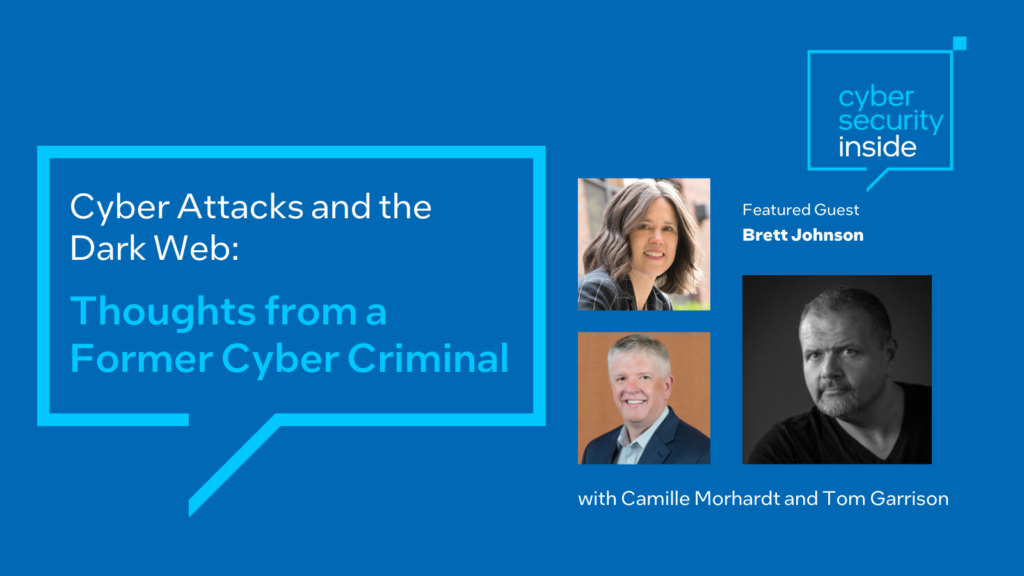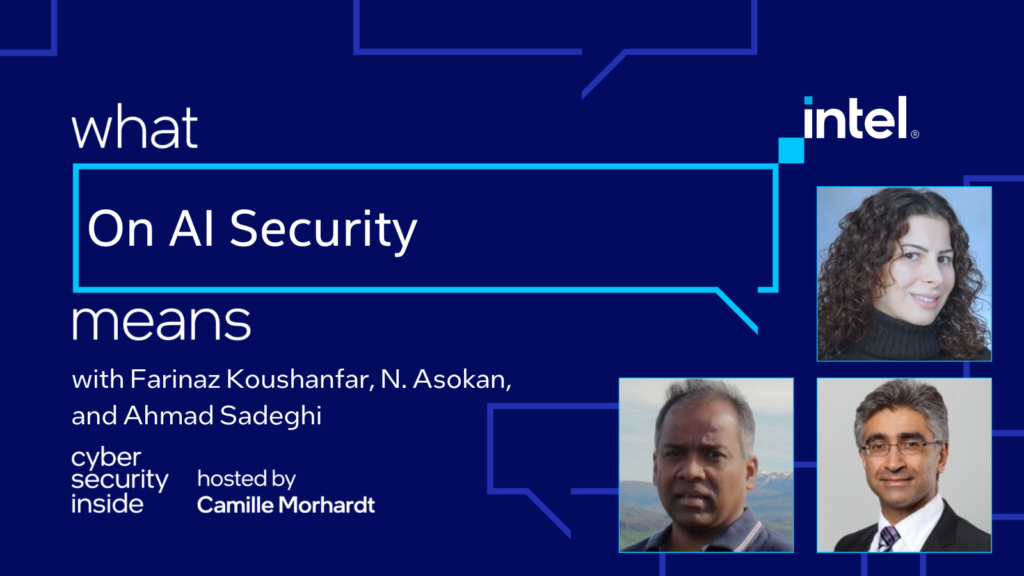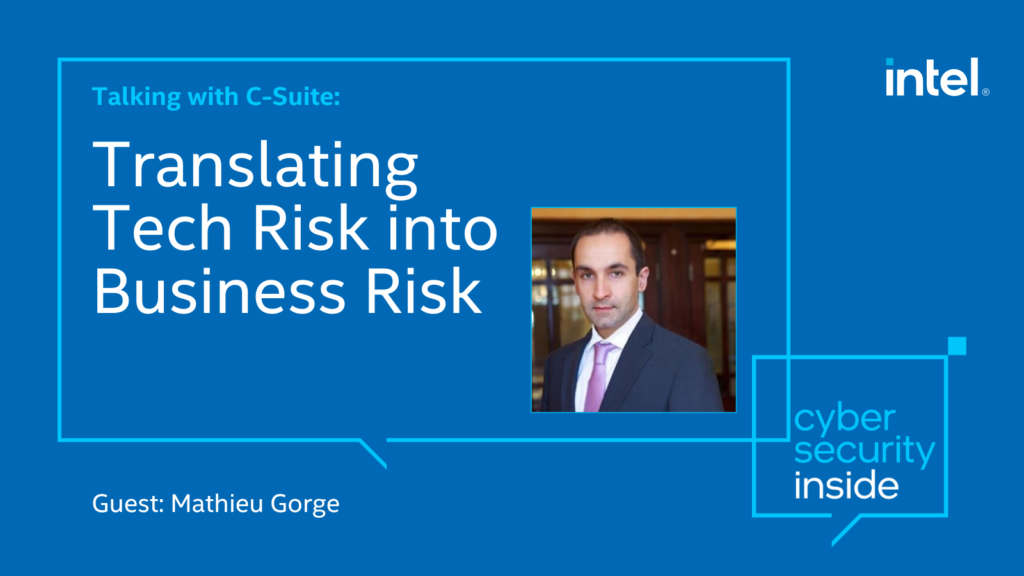[00:00:36] Camille Morhardt: Hi, and welcome to today’s episode of What That Means, part of Cyber Security Inside podcast. I’ve got Lee Phillips with me to talk about 5G and 6G technology. Lee Phillips is a Director and Senior Wireless Strategist at Intel, and he advises Intel’s Global Supply Chain on wireless technologies. He pretty much knows everything about radio frequency. I’ve worked with him in the past, and I’m really delighted to have him on. Welcome, Lee.
[00:01:06] Lee Phillips: Thanks for having me.
[00:01:07] Camille Morhardt: So, 5G and 6G, kind of a big topic, and I’m wondering if you can just start us off by defining what is 5G?
[00:01:19] Lee Phillips: So, 5G is fifth generation wireless. So, we started out with 1G or amps back in the early ’90. Then 2G came–the 2G flip phones and so forth came, the brick phones, back in late-90s, early 2000s. 3G came around mid-200s, 2005 and 2006. Then 4G came around 2013, 2014. Now we’re in 5G. 5G is being ratified as a new standard for both communications protocol and usages.
So, what 5G really is, is it’s using a 5G protocol to translate data from a device to an end device. Therefore, 5G can exist in three different flavors. One flavor is the maximum broadband called EMBB, enhanced mobile broadband. Another flavor is ultra reliable communications where you have autonomous things like autonomous factories, URLLC. Then the third is we have an ever expansive sensor technology network called MMTC, Massive Machine Type Communication. And all that, the 5G protocol, is used to translate the data from one device to the next.
[00:02:35] Camille Morhardt: Okay, so in the past, if we go back a couple generations to 2G or 3G, was there only one of those vectors? You’re almost talking about like a triad of like maybe completely totally differently evaluated benefits of the technology, one being I’m going to be able to stream my videos better and faster than anything else, and the other one being I’m going to do really efficient Internet of Things communications. Did we have those differences in prior generations?
[00:03:06] Lee Phillips: Absolutely. And 1G, 1G was analog. Analog is when you have these giant batteries and these giant phones. Because analog uses so much current, you had to have a giant battery in the giant form factor of your end device in order to support that protocol.
Then we got the first digitized communications in this space was 2G. It came out as GMSK and 8PSK. Right? So, phase PSK is phase-shift keying. So, in 2G, that was about 200 kilohertz bandwidth. Right? So, now you have the digitized protocol using less battery, less energy, and you can do phase-shift keying between different channels such that you can actually communicate in a digitized way. But that was very limited. It’s only voice calls and some SMS or some text calls. Very, very limited.
Then we move to 3G. 3G has a an average of five megahertz bandwidth. Now you have 20X the bandwidth. Now you can start doing things, just calls SMS, and now start to do some data analytics or data translation, not just voice but data now. Right? So, that was limited as well because we had just a through pipe that was five megahertz wide in bandwidth. Then we move into 4G. 4G was a different beast all together.
[00:04:29] Camille Morhardt: This gave us video calls and whatnot, right?
[00:04:32] Lee Phillips: Exactly.
[00:04:33] Camille Morhardt: Streaming and… Okay.
[00:04:34] Lee Phillips: Exactly. 4G was programmable from… Again, 2G had 200 kilohertz bandwidth. Now 4G or LTE has 1.4, three megahertz, five megahertz, 10 megahertz, 15 megahertz, and now up to 20 megahertz bandwidth. So, now you can have a giant pipe of data that can actually translate to things like you said, video calls and so forth.
But it was also still limited in terms of usages. You can’t take a 4G network into an automated factory because of latency issues. You couldn’t take a 4G network and build out a Massive Machine Type Communications network of millions of devices because of the protocol itself. It was inefficient in terms of how to translate that data into multiple end usages without a very, very expensive infrastructure.
And now comes 5G. 5G is then broken down into, again, it takes that 4G anchor, 1.4 to 20 megahertz bandwidth. So, for Massive Machine Type Communications, it actually takes a different protocol and instantiates it such that it can have up to a million devices connected to a network. Then it also takes the latency from one to four seconds of latency in some extreme usages down to around 10 milliseconds so that now you have more real time human machine interface connections. So, again, 5G is taking the best of 4G, then adding the ultra reliable networks, and adding the ultra connected sensor networks.
[00:06:03] Camille Morhardt: What is Massive Machine Type Communication?
[00:06:06] Lee Phillips: Okay, so for LTE, which we all have LTE phones today. Well, we should cause they’re shutting down 3G across the globe. So, for LTE, you can connect up to 2,000 devices per base station. So base station is a center of a cell, hence cell communications, cellular communications.
So now, 5G, you now have up to one million devices connected to a single base station or single communications node. For instance, if you want to go into a college campus, or if you want to go to a connected office space, you can now have multiple devices connected to the same 5G protocol for cellular, in this case 5G, and then offset some of the wifi traffic onto a cellular network.
[00:06:49] Camille Morhardt: This is done primarily because we have so many more devices connecting, be they additional cellphones, but also Internet of Things type of devices that we didn’t have as many of before. So, we just have to basically make room for more nodes connecting.
[00:07:05] Lee Phillips: This is correct now. Now I’ll say a couple things. Right? So, now we walk around with our devices on person. We drive around with our devices in our garage and outside in the ecosystem. Shorter range technologies like wifi and Bluetooth are up to maybe 50 meters–on a great day 50 meters, line of site. 5G can go up to 50 kilometers.
So, now we can have both on-premise and off-premise connectivity, and having a seamless download or upload of that connectivity for one usage. You can be on a video call talking to your mother. You have your kids in the car. You start the conversation. Everyone’s talking. You drive away from the home, take your kids to the doctor or to the mall, and your call continues with the same video quality as at home as in your car at the doctor’s office.
[00:08:01] Camille Morhardt: What about when you go in the parking garage after the appointment, does it drop?
[00:08:05] Lee Phillips: That depends. So 2G, it was at 800 megahertz and 900 megahertz. So, the lower the frequency, the better the penetration through things like garages and so forth. When we went to 3G… So, 2G had four bands. Right? 800, 900, 1800, 1900. Right? So, low band and high band. You go to 3G, you got 10 bands. The same bands of 2G, now you added additional high bands such that you can have higher data throughput, higher band with usages.
You go to 4G, now you have, I think, up to 44 bands is the last I’ve counted that we have, again, the same 2G bands, the same 3G bands, and a multitude of low, mid, and high to use the spectrum more effectively in order to reach whatever usage that you may need. But at the same time, when you use the lower channels or the lower frequency bands, it uses more energy.
Think about if you have a teenage son, and you hear him playing his music in the garage or in the parking area, you don’t hear people talking the higher frequency, but you hear the base, the lower frequency. In order to generate that lower frequency, it takes more energy to generate those longer wavelength sounds. So, the answer is theoretically yes, but it depends on how the device is set up in order to reach… the usages programmed into the modem and into the modem setup in order to reach those extreme usages.
[00:09:34] Camille Morhardt: I’m trying to get this visual on all of these different wavelengths that I can’t see as I walk down the street or as I sit in my car or in my apartment. Where are all of these things, and what kind of information do they contain?
[00:09:47] Lee Phillips: So, we start at zero, DC, direct current at one end of the spectrum, and daylight at the other end of the spectrum. Above terahertz is daylight. Right? Now in between zero hertz and daylight, this is called DC to daylight as we call it in the industry, there are multiple usages.
So, back in the day, the government says, “I want to establish these early usages.” One of those early usages was AM radio. So, AM radio is in a very low frequency range such that when you travel in your car, you rarely lose connection to an AM radio.
[00:10:27] Camille Morhardt: Right. Even over the pass, it says, okay, if you tune in here for road conditions, it’s always AM. That makes sense.
[00:10:33] Lee Phillips: Correct. Even sometimes in tunnels because it’s a lower frequency range. And AM is a big chunk of frequency. So, a lot of government usages used to use AM radio because it had that ultra connectivity, pun intended. But below AM radio and above AM radio, there are different usages as well. For instance, some of your maritime. You’re boating. And all the radio usages across the spectrum of usages is contained in this, again, DC to daylight.
Now more specifically towards cellular. Cellular starts around 450 megahertz. It’s only used in a variety of ways, a smaller variety of ways, than traditional cellular that starts at 698 megahertz. So, the 698 megahertz, again, is at low band while I was talking about 2G. So, when 3G came on, it added bands up to 2.4 gigahertz. At 2.4 gigahertz, it is the same frequency band for Bluetooth and wifi.
So, now we have cellular, Bluetooth, and wifi in the same frequency band. If I’m talking on my cellphone, I’m going to reject the wifi signals, I’m going to reject the Bluetooth signals. And by the way, GPS also exists there, so I’m going to reject the GPS signals. Or if I’m using my GPS as a receiver, if I’m making a phone call, I’m going to reject my cell frequencies such that my GPS can actually be accurate and work with my usage model. Right?
So, now we’re starting to have multiple radio usages in the same frequency bands. This is why a lot of these things, more usages, more radio technologies come on board, this is why our devices become more complex. Because we want to actually use our device in a way that doesn’t interfere with our environment. And by the way, we want to use the other usages for our other radios so that it doesn’t interfere with our cellular. (NOTE: Multiple technologies (Cellular, Wi-Fi, GPS, Bluetooth) operate near the same frequency @2.4GHz but use different wireless protocols where adjacent band interference is a key challenge.)
[00:12:32] Camille Morhardt: Why are so many technologies in the same band? Why don’t they use different bands? Is that band easier to do something with, or the information goes better through that band?
[00:12:42] Lee Phillips: The FCC governs what radio frequency bands are used for what usage, maritime, satellite, geospatial, whatever. Right? You could have a Fitbit on your bicycle. It all falls into these usages. In this case, 2.4 gigahertz was allocated to… And by the way, 2.4 gigahertz comes in multiple bandwidths now. Right? So, as I said, 2G came up with 200 kilohertz bandwidth. 3G, it actually is 3.84, but I’ll say five megahertz bandwidth, 20X. 4G LTE came in, programmable bandwidth from 1.4 to 20 gigahertz.
5G takes that same programmable bandwidth and then instantiates URLLC for automation and MMTC for sensor rich environment. So, now because we have multiple usages, as defined by the government entity, our regulatory body, FCC, we have to then develop technologies that can actually be used as a singular device and be used in a multi-device environment. It’s called coexistence.
[00:13:49] Camille Morhardt: Is it possible to run out of bandwidth?
[00:13:52] Lee Phillips: Yes.
[00:13:53] Camille Morhardt: Is there a horizon for that? Are we worrying about that now, or is that just a theoretical possibility?
[00:13:59] Lee Phillips: So, we have to talk about what is bandwidth and how it is consumed. Right?
[00:14:03] Camille Morhardt: Yes. Yeah, we do. Yeah.
[00:14:04] Lee Phillips: Right. So, what is bandwidth? So, this bandwidth is the amount of data that can be translated through a communications pipe, either wired or wireless. In this case we’re talking wireless, that can be consumed at the other end, and then a ping or a response back from that consumption back to the originator, the base station in this case, of that signal such that you can actually correct the signal integrity and correct the power, correct the frequency, correct the accuracy of the message, it’s called EVM, Error Vector Magnitude, such that you can actually translate and transfer an available set of packet of data to the end device.
Now, all that being said is the more data I pump through a single channel, the more other things can’t use that channel. And therefore, we can’t have one pipe for all traffic in the same frequency band. So, right now on your cellphone, you have cellular and wifi Bluetooth in the same phone, and you have GPS in the same phone, all using 2.4 gigahertz.
So, what the wifi guys did is says, “Guys, this thing is getting congested. I’m not getting enough wifi through. So, I’m going to create a five gigahertz wifi band.” Right? Now we have 2.4 and five gigahertz. The GPS guys are like, “Guys, I’m on GPS. I have nine channels on GPS. I can’t use channels one through five because that is the high band of cellular. I want to use the channels six through 15 or whatever for GPS because that’s congested. And I can receive my GPS from whatever satellite and have very good fidelity and signal integrity.” Or “Guys, today I’m watching my Netflix on my phone. My phone is now tethered, wifi or Bluetooth, to my Roku or my smart TV, but I want to be able to receive video calls off the same Roku, to my smart TV, and talk to my mother.” In order for all that stuff to happen, I now have to actually manage the bandwidth such that each device have interplay with other devices in the same frequency channel, again, back to the frequency channel, and the same type of bandwidth usages, but I actually schedule bandwidth usages based on the usages of the devices.
[00:16:22] Camille Morhardt: Without interfering with it so that you can have both things happening at the same time.
[00:16:26] Lee Phillips: Exactly. Exactly.
[00:16:28] Camille Morhardt: When do we see broad adoption of 5G? When are essentially most things using it?
[00:16:33] Lee Phillips: So, right now they’re sunsetting 2G and 3G, both highly inefficient. So, 2G is a one amp technology. 5G, again, is broken down into multiple usages. So, the high bandwidth side is going to use more current or more power than the ultra critical side for automation than the Mass Machine Type Communications for sensored networks.
So, it depends on the usage. Right? But I would say every five, six years, these technologies evolve from one protocol to the next. So, now we have, again, as I said, back in 2013, LTE came alive in a very real way. But LTE was defined by 3GPP, the radio standard, in 2006.
[00:17:20] Camille Morhardt: Yeah.
[00:17:21] Lee Phillips: It took that many years for it to come off. So, 5G defined in 2019, and now it’s 2022 today. It’s going to be a couple of years before it starts to really ramp in a real way. But 2G and 3G are being sunset. Now the LTE anchor is there, and 5G uses that LTE anchor. So, now we can market 5G devices using an LTE anchor. So, you’ll see a lot of marketing on 5G devices, but they’re really using an LTE infrastructure.
True 5G is standalone. Right? So, that 5G standalone will likely… The market analysis is all over the place because it’s regional. Korea is, in some cases, leading. China has the most 5G base stations built out in the world, in some cases leading. AT&T, Verizon, and so forth, North America, has the latest devices, but the infrastructure is lagging China. So, it depends. It’s regional. But around 2023, 2024, we’re expecting to see a giant boom.
[00:18:24] Camille Morhardt: Okay, so one more thing, one more question. We’re putting out all… filling the airwaves with transmissions in all different frequencies, getting more and more and more subdivided within that. Is there any concern or is there any look at biological implications to transmitting so much information all over the place and continuing to fill that in?
[00:18:49] Lee Phillips: So, there are actually bodies, regulatory bodies, in the government that study things like SAR, surface absorption rate. When your phone transmits this 2.4 gigahertz or five gigahertz frequency or your wifi, and your body accepts this, it passes into your body or through your body, what happens to your body?
Now at the same time, bodies that define new radios, radio usages, radio technologies, they must take into account how it impacts the human body. Not just human body, animals as well. So, a lot of farms around the Midwest and the big farm areas have cell towers on them, because that’s cheap land, generally flat. They can reach a large area of population in that space. Right? At the same time cows and things that we consume, vegetables that we consume, are in the same space.
So, there’s a lot of study here in the space.* But I would say the answer is yes, these things do impact our bodies. And up to now, the latest technologies that we are aware of, the technologies that are being defined by the regulatory bodies and that are being brought forth by the technologists themselves like Intel, meet those requirements by these regulatory bodies. I guess the impacts are mitigated.
[00:20:10] Camille Morhardt: Do you wear your cellphone on your person?
[00:20:14] Lee Phillips: Not all the time. No. I do have a healthy separation between this ubiquitous technology environment and my person. I think everyone should do that. We are humans, not an autonomous bot, right? So we need to have a healthy connection between our environment and ourselves.
[00:20:32] Camille Morhardt: Lee, it’s been so good to catch up with you today. And you’re such a wizard when it comes to understanding and articulating really complicated technology. Thank you so much for being on the show.
[00:20:44] Lee Phillips: Thank you for having me. And I really do support what you’re doing, not just for Intel, our mutual company, but for our world. We need to talk about these tough topics. So, thank you for your mission in this space.
* For more context around radiation use in airports: What Do Airport Body Scanners Really See? Can They See You Naked? (rd.com)
 wireless technologies, and is an expert on all things radio frequency. He is the perfect person to talk about 5G and 6G on today’s podcast!
wireless technologies, and is an expert on all things radio frequency. He is the perfect person to talk about 5G and 6G on today’s podcast!


